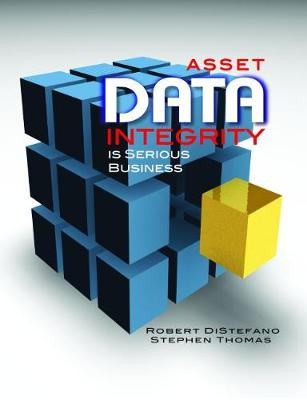If your asset data is not reliable, you need to convince the organization of the enormous potential that is locked away. To accomplish this, you need to understand the breadth of the problem and the value of solving it. A viable business case for action is needed-so let's get started!
Physical asset data integrity is a critical aspect of every business, often the most valuable asset on the balance sheet, yet it is often overlooked. The data that we have about our assets collectively creates information, provides for accurate analysis and facilitates sound business decisions. Without accuracy of asset data there is a strong potential for poor decisions and their negative consequences. This book will not only provide an appreciation of this fact, it will also provide a road map to achieving value out of something most CEOs, managers, and workers often overlook.
Acknowledgements
About the Author
Introduction
1-The Business Case for Data Integrity
- Introduction to the Business Case
- Information Overload
- Searching for Data
- Retiring Baby Boomers
- The Brain Drain
- A Business Case Example
- Consistency or Lack Thereof
- The Data Integrity Corporate Entitlement
- Impact on Shareholder Value
Part 1-Understanding the Importance of Asset Data Integrity2-Plant Asset Information-A Keystone for Success
- Overview
- Who Are The Stakeholders?
- Why We Wrote This Book
- Who Will Benefit?
- What You Will Learn
- Chapter Synopsis
- Let’s Get Started
3-What is Data Integrity?
- Defining the Terms
- Data Elements
- Taxonomy and Why Is It Important?
- What We Are Looking for in Good Data
- The Downside of Poor Data Integrity
- A Word About Information Technology
- Understanding Data Is Just the Beginning
4-The Asset/Data Integrity Life Cycle
- About Life Cycles
- The Asset Life Cycle
- The Asset Data Life Cycle
- Why the Data Life Cycle is Important
- Roles and Responsibilities Within the Asset Life Cycle
- It Is Never To Soon To Start
- Life Cycle Links
- Life Cycles as a Foundation
5-Data Integrity at the Task Level
- Task vs. Strategic
- The Data Integrity Transform
- Data Integrity Tasks
- Reactive Data Integrity
- Proactive Data Integrity
- From Reactive to Proactive
6-Internal Outcomes and Impacts
- Indirect Impacts
- Decisions Are Just the Beginning
- Indirect Inputs
- Indirect Outputs
- The Legal Umbrella
- Indirect Aspects of the Transform
7-External Outcomes and Impacts
- External Issues
- Outcomes and Impacts – Partners
- Outcomes and Impacts – Suppliers
- Outcomes and Impacts -Customers
- Outcomes and Impacts -Agencies
- Outcomes and Impacts – Public
- Outcomes and Impacts – Insurance Carriers
- The External Impacts Are Important
8-Information Technology (IT) Problems and Solutions
- The Implication for IT
- Implications to IT of a Modern Asset Data Management Practice
- The Advent of ERP Systems
- Master Data Management
- The Future
Part 2-Building a Sound Data Integrity Process9-Building an Enterprise-Level Data Integrity Model
- Historical View
- What Is an Asset?
- Asset Classification
- Static Data vs. Dynamic Data
- The Differences Among Assets, Functional
- Locations and Functional Location Hierarchies
- Other Asset-Related Master Data
- Asset Master Data Structure and Formatting
- Ideal Asset Data Repositories
- Enterprise-Level vs. Plant-Level Asset Data Integrity
10-Building an Enterprise-Level Inventory Catalog Data Integrity Model
- The Model For Material
- What Is a Spare Part?
- Items Classification
- Static Data vs. Dynamic Data
- Ideal Item Data Repositories
- Enterprise-Level vs. Plant-Level Item Data Integrity
11-Data Integrity Assessment
- Data Quality Dimensions – The Beginning
- The Approach to the Assessment
- The Initial Steps
- The Assessment-General Comments
- The Assessment Process
- Moving Forward
12-Assessment Details-Assets and Material Items
- Similar But Different
- Assessing Asset Data
- Assessing Material Data
- Data Strategy Session
- To-Be Taxonomy
- Primary Data Fields
- Class and Subclass
- Manufacturer or Supplier Name
- Asset-Model Number or Serial Number
- Material Items-Manufacturer or Supplier Part Number
- Attribute Templates
- Other Asset Data Fields
- The Goal-Quality Data for the Future
13-Asset Clean-Up and Repair
- After the Assessment
- Data Repair is Far from Simple
- Repair Problems
- Data Repair Strategies
- The Big Bang Approach
- Fix It As You Go
- The Line in the Sand-More on Sustainability
- Commitment to Doing the Work
Part 3-Sustaining What You Have Created14-Data Governance
- Data Governance-Insight to the Problem
- Shifting the Burden
- The Long Term Solution
- The Benefits of Data Governance
- The Jobs of Data Governance
- It’s All About Policy and Controls
- Roles and Responsibilities
- When Should We Start?
15-Sustaining What Has Been Created
- The Need to Sustain
- Establishing Ownership
- Communication
- Process and Procedures
- Training
- Prepare for Data Growth
- Walking the Walk
- Quality Control and Quality Assurance
- Using Key Performance Indicators
- The Continuous Improvement Cycle
- Sustainability Is Not Optional
16-Data Integrity Is Serious Business
Bibliography
Index
- ISBN10 0831134224
- ISBN13 9780831134228
- Publish Date 15 October 2010
- Publish Status Active
- Publish Country US
- Imprint Industrial Press Inc.,U.S.
- Format Hardcover
- Pages 312
- Language English
